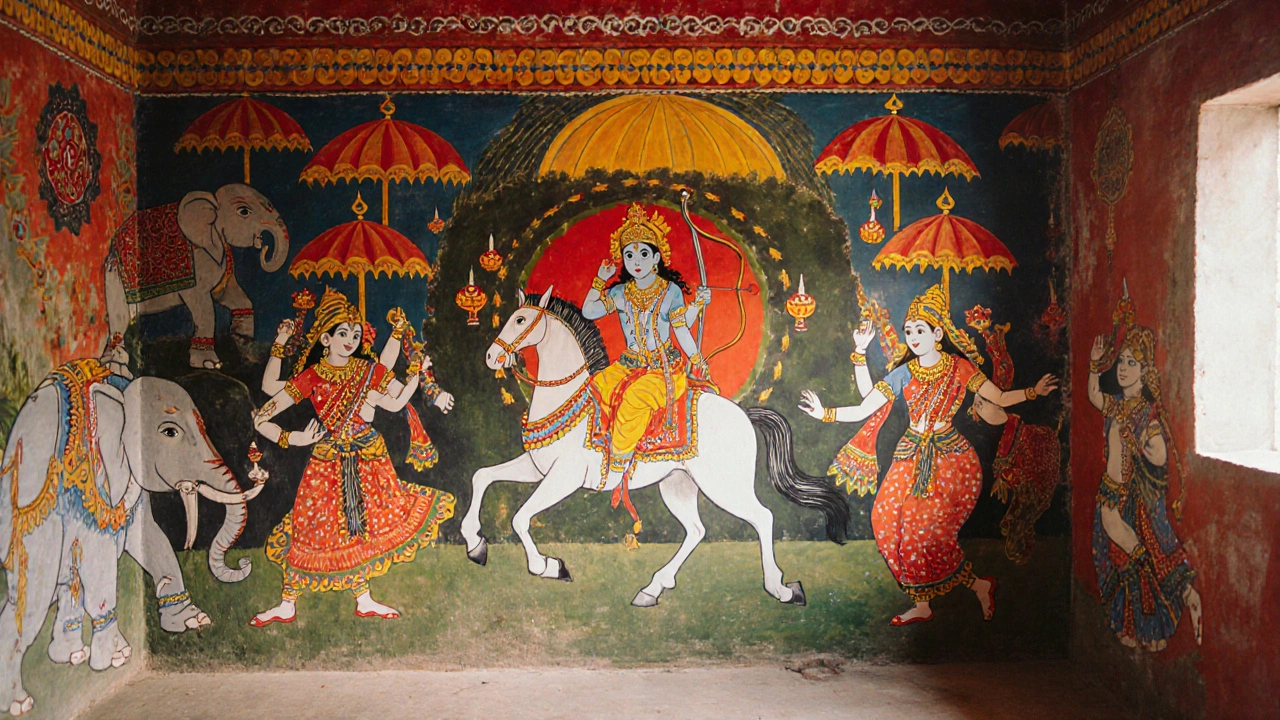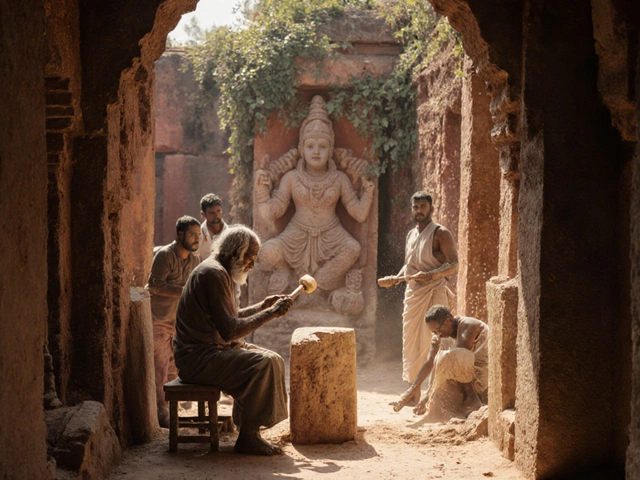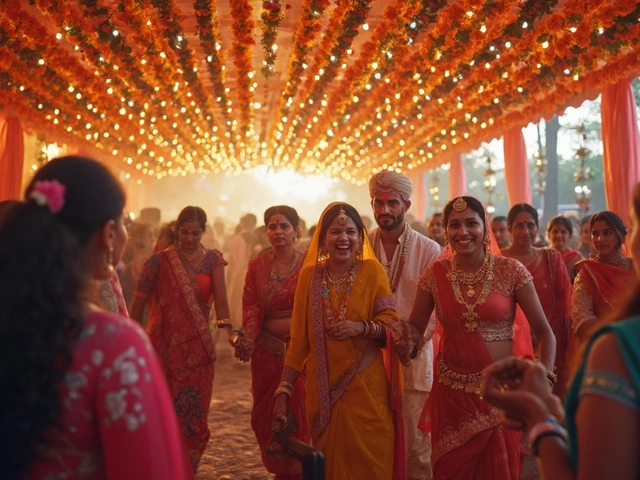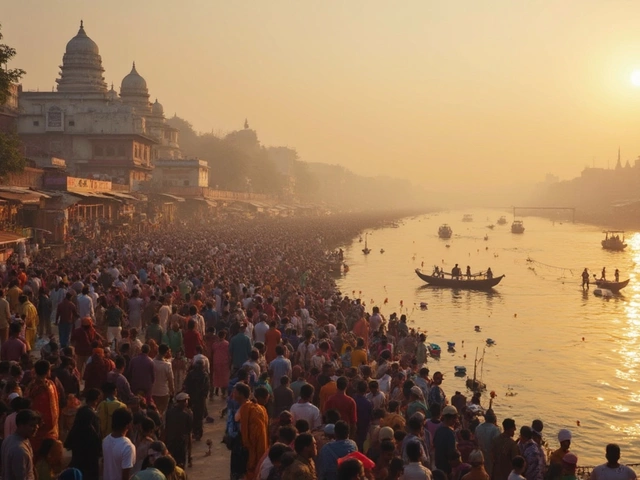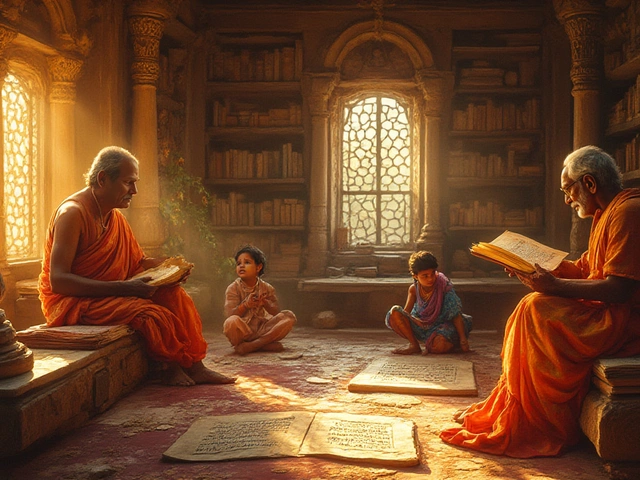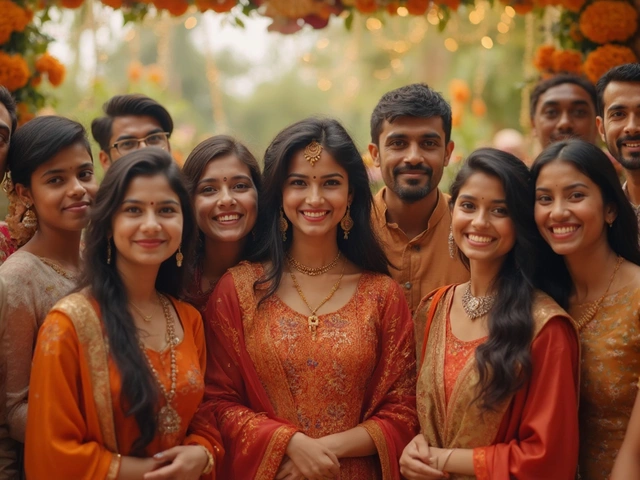Pithora Symbol Explorer
Discover the hidden meanings behind the vibrant symbols of Pithora paintings. These sacred murals from Gujarat's tribal communities are more than just art—they're spiritual narratives. Click on each symbol to understand its significance in the ritual context.
Rido (Central Deity)
The horse-riding god who carries prayers to the heavens. Represents divine protection and spiritual guidance.
Rido is the most important figure in Pithora art. He's not just a deity but a messenger between humans and the divine. His horse symbolizes speed and protection, while his bow and arrow represent spiritual strength. Each painting is created specifically for the family's vow to this deity.
Horse
Represents speed, protection, and spiritual journey. The horse carries Rido to the heavens.
The horse isn't just a decorative element—it's the vehicle for Rido's journey between worlds. In Pithora rituals, the horse symbolizes the family's hope for divine intervention and protection from dangers. Different colors of horses carry different meanings.
Peacock
Symbol of beauty, divine presence, and spiritual elevation.
The peacock represents the divine presence in everyday life. Its beauty is seen as a gift from the gods, and its feathers are believed to carry spiritual energy. In Pithora paintings, peacocks often surround Rido as a sign of divine blessing.
Lamp
Represents the light of truth, knowledge, and spiritual enlightenment.
The lamp in Pithora paintings symbolizes the light of truth that guides families through difficult times. It's often placed near the deity to represent the divine light that dispels darkness. In rituals, lamps are lit as part of the ceremony to welcome the deity.
When people think of Gujarat’s art, they often picture intricate embroidery, colorful puppets, or terracotta pottery. But one of the most powerful and lesser-known visual traditions from the state is Pithora painting-a vibrant, spiritual mural art born from the rituals of tribal communities. It’s not just a painting. It’s a prayer made visible.
What Exactly Is Pithora Painting?
Pithora painting is a ritualistic art form created by the Adivasi communities of northern Gujarat, especially among the Rathwa, Bhilala, and other tribal groups. These paintings aren’t made for galleries or tourists. They’re created inside homes, on walls or ceilings, as part of a sacred vow called Pithora-a promise made to the deity Rido or Pithora Baba when someone is healed from illness, saved from disaster, or granted a child.
Unlike other folk art forms that focus on decoration, Pithora paintings are functional. They serve as a spiritual contract between the human and the divine. The moment the vow is fulfilled, the family hires a painter-usually a member of the community who inherits the skill from elders-to create the mural. The painting becomes a living record of gratitude.
The Symbols and Stories in Pithora Art
These paintings burst with color: red, yellow, green, blue, and white made from natural pigments like crushed stones, plant dyes, and lime. The central figure is almost always Rido-a horse-riding deity who carries the soul’s prayers to the heavens. He’s often shown with a bow and arrow, sometimes holding a sword or a drum.
Surrounding Rido are other figures: animals like horses, elephants, and peacocks; human figures dancing or offering food; and symbolic objects like umbrellas, lamps, and chariots. Each element has meaning. A horse means speed and protection. A peacock represents beauty and divine presence. A lamp signifies the light of truth.
There’s no fixed layout. No two Pithora paintings are the same. The artist works intuitively, guided by the family’s story and the deity’s instructions, often received in dreams. This makes each piece a unique narrative-part myth, part memory, part miracle.
How Is It Made? The Ritual Process
The creation of a Pithora painting is as important as the final image. It begins with a ritual called Pithora Vrat. The family fasts, offers milk and jaggery, and invites a priest to chant mantras. Then, the wall is cleaned with cow dung and lime to purify it. Only after this is the painting begun.
The artist uses a brush made from the hair of a goat’s tail, dipped in natural colors. The work starts from the bottom and moves upward. The painting is done in one continuous session-often lasting 12 to 24 hours. No sketches are made. The artist draws directly, trusting memory and spirit.
Once complete, the family holds a feast. Neighbors gather. The painting is blessed. It stays on the wall for years, sometimes decades, becoming part of the home’s spiritual fabric. When the wall cracks or the house is renovated, the painting is carefully removed and preserved-never thrown away.
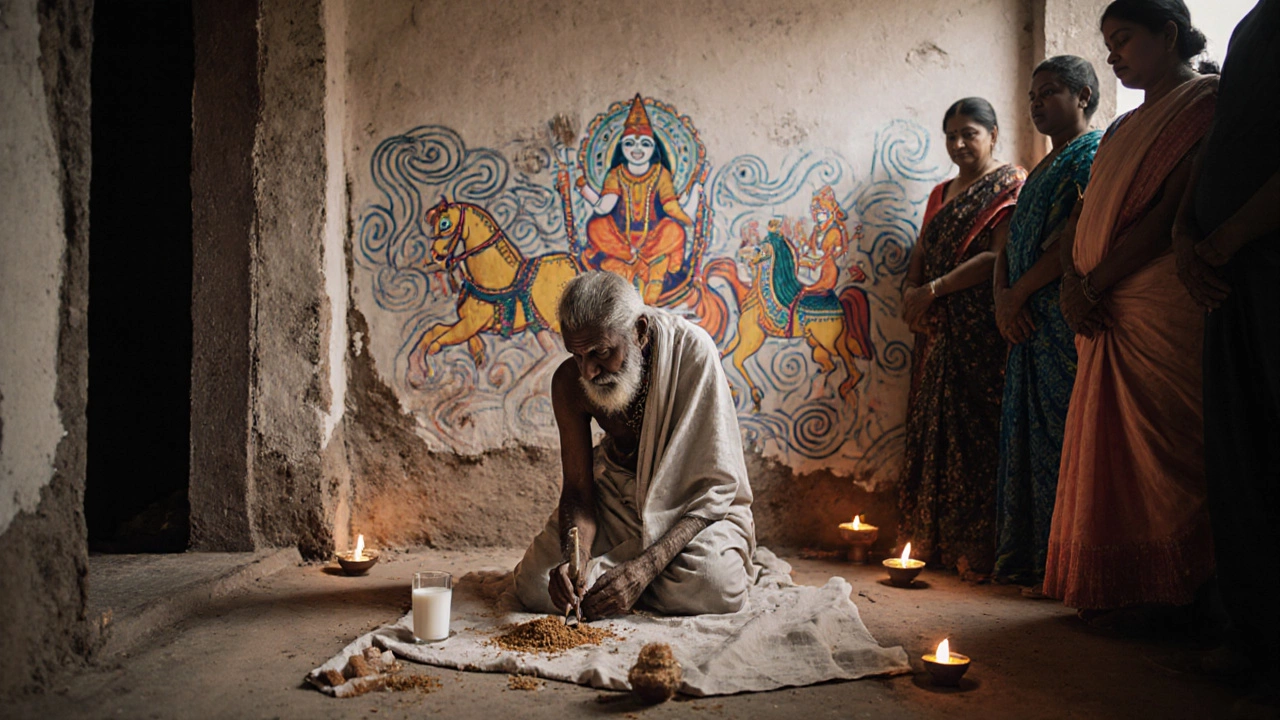
Why Is Pithora Painting So Rare Today?
There are fewer than 50 active Pithora artists left in Gujarat today. Most are over 60. Younger generations are moving to cities for jobs. Schools don’t teach it. The rituals are fading as modern medicine replaces faith-based healing.
Some museums and collectors have started buying Pithora paintings, but this risks turning sacred art into a commodity. When a painting is sold, it loses its spiritual context. The deity it was made for no longer receives the offering. The story it tells becomes a decoration, not a prayer.
Organizations like the Gujarat State Handicrafts Development Corporation and NGOs like the Pithora Art Foundation are trying to preserve the tradition. They train young artists, document oral histories, and help families create new paintings without selling them. But the real hope lies in keeping the ritual alive-making sure the vow is still made, and the prayer still painted.
Pithora vs. Other Tribal Art Forms in India
India has many rich tribal art traditions. Warli from Maharashtra uses white dots on red mud. Bhil art from Madhya Pradesh features bold outlines and repetitive patterns. Gond art is known for intricate linework and nature motifs.
Pithora stands apart because it’s tied to a specific vow and ritual. It’s not just about aesthetics-it’s about transformation. While Warli and Gond art have become popular in home décor, Pithora remains deeply personal. It doesn’t just show a story-it holds one.
Where Warli depicts daily life, Pithora depicts the unseen: gods, spirits, and divine intervention. Where Gond art celebrates nature, Pithora asks for protection from it.
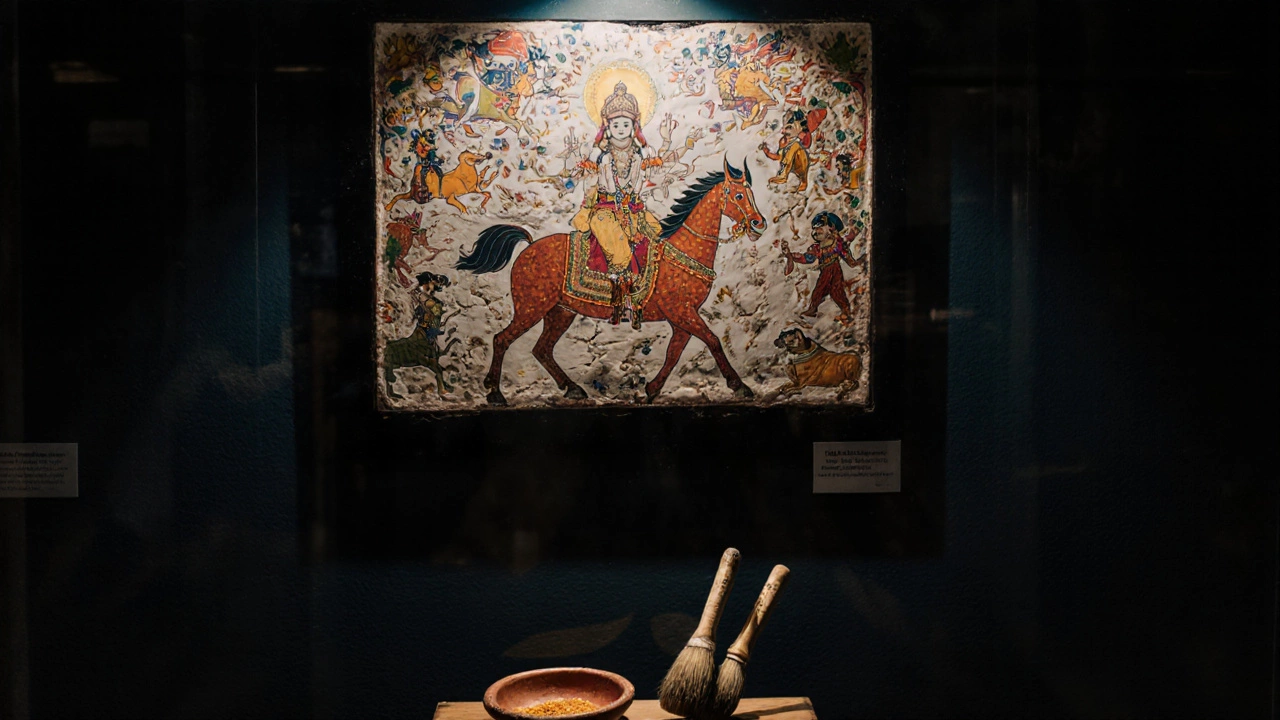
Where Can You See Pithora Paintings Today?
Most Pithora paintings are still in private homes in districts like Dang, Sabarkantha, and Vadodara. But you can find preserved pieces in a few places:
- National Museum of Indian Culture in New Delhi has a small collection of restored Pithora murals.
- Shree Kaviraj Museum in Ahmedabad displays original paintings donated by tribal families.
- Dang District Museum in Vansda has the largest public collection, with over 40 pieces.
Visitors are welcome, but photography is often restricted. These aren’t exhibits-they’re sacred spaces.
How to Support Pithora Art Without Exploiting It
If you’re moved by Pithora art, don’t buy a mass-produced print. Don’t ask an artist to make a copy for your living room wall. Instead:
- Visit a museum that supports tribal artists and pays them fairly.
- Donate to organizations preserving the ritual, like the Pithora Art Foundation.
- Share the story. Tell others this isn’t just art-it’s living faith.
- If you’re connected to a tribal family, help them document their own Pithora traditions-record the chants, the names of deities, the reasons the painting was made.
Preserving Pithora isn’t about saving a painting. It’s about saving a way of seeing the world-one where the divine walks on horseback, and gratitude is painted on walls.
Is Pithora painting the only famous art from Gujarat?
No, Gujarat is known for many art forms like Patola silk weaving, Kutch embroidery, and Dhokra metal casting. But Pithora is unique because it’s tied to spiritual rituals, not just craft. It’s not made for sale-it’s made for prayer.
Who is Rido in Pithora paintings?
Rido is the central deity in Pithora art-a horse-riding god who acts as a messenger between humans and the divine. He’s believed to carry prayers, protect families, and grant wishes. His image is always painted with a bow, arrow, or sword, and he’s surrounded by symbols of power and abundance.
Can I commission a Pithora painting?
Technically yes, but it’s not recommended. Pithora is a ritual art tied to a vow. If you commission one without the spiritual context, you’re removing its meaning. If you want to support the tradition, help fund a family’s actual ritual instead of buying a copy.
Are Pithora paintings still being made today?
Yes, but very rarely. Only a handful of elders still know how to paint them properly. Most new paintings are created under preservation projects, not as part of living rituals. The tradition is at risk of becoming a museum piece unless the spiritual practice returns.
What colors are used in Pithora paintings?
Traditional Pithora paintings use natural pigments: red from geru (iron oxide), yellow from turmeric or stone, green from leaves, blue from indigo, and white from lime or chalk. These are mixed with water and applied with goat-hair brushes. Modern versions sometimes use acrylics, but purists reject them.
